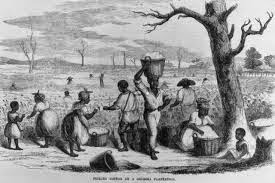The power
dynamic between a slave and a master was surprisingly not as absolute as many
slave owners would have liked or a historian would have initially thought. The plantations are the most notorious slave
households in American History, where a single plantation would amass well over
200 slaves, but they only accounted for less than 1% of slave owners, as the
overwhelming majority could only afford one or two at a time.[1] Yet both one to one ownership, plantation
slavery, and slave ownership between those two required a give and take between
masters and slaves. It was imperative not
only for a successful slave owner, but for society as a whole to find a way to
balance the known humanity of the slave with the reality of the grueling work
that the slave owners had bought their slaves to accomplish. To outright ignore their humanity could
potentially increase the risk of a slave riot.
For slave states such as South Carolina, where the majority of the
population were in fact black slaves[2],
the thought of revolt was a frightening endeavor.
At
the same time treating them as equals or as human beings with rights was out of
the question. The business of slavery
was a robust enterprise as Stephanie Smallwood brilliantly detailed in Saltwater
Slavery. Slavery was a global enterprise
that fueled jobs such as shipwrights, navigators, and chain makers. Slavery
propped up every business industry possible.[3] This economic freedom would allow many slave
owners to invest in other institutions that could potentially benefit their
society,
“All of early America’s leading universities, both
north and south, promoted and profited from slavery, racism, and colonialism.”[4]
America and particularly the American South
was a slave society and thus it was all encompassing and impacted society
socially, politically, and economically.
The
charade needed to be perpetuated so as to continue sustaining the multitude of
institutions that slavery had built up. Thus
it was necessary to both physically and mentally oppress slaves and later
retroactively justify the benefits of slavery.
“From an early
age slaves’ bodies were shaped to their slavery. Their growth was tracked against their value;
outside the market as well as inside it, they were taught to see themselves as
commodities.”[5]
Slaves then
were naturally unable to learn new crafts and trade due to the physical and
mental oppression that consciously molded them into the needed tools that the
slave owners and that society deemed to fit them.
“…What that trust is must be ascertained from the
necessities of their position, the institutions which are the outgrowth of
their principles and the conflicts through which they preserve their identity
and independence. If then the South is such a people, what, at this juncture,
is their providential trust? I answer, that it is to conserve and to perpetuate
the institution of domestic slavery as now existing…We know better than others
that every attribute of their character fits them for dependence and
servitude.”[6]
Supposedly “rational” arguments could then be
made in order to defend the institution of slavery against those who would
oppose it on the basic tenets of slavery’s inhumanity. This straw man argument
would of course have the backing of churches and colleges, or the spiritual and
intellectual elites within the South, as both these institutions naturally
benefited immensely economically from slavery.
Which makes the power instituted by
the slaves themselves within this oppressive state all the more impressive. The slaves consistently resisted the idea
that they were just slaves, or just chattel to be shipped elsewhere. They were human and they enacted their
humanity by subverting the culture they were forced into, whether through trade
or through birth itself.
“They disrupted their sales in both philosophy and
practice. In philosophy by refusing to
accept their owners’ account of what was happening, by treating events that
slaveholders described in the language of economic necessisty or disciplinary
exigency as human tragedy or personal betrayal.
In practice by running away or otherwise resisting their sale, forcing
their owners to creat public knowledge of the violent underpinnings of their
power.”[7]
The slaves
understood that they were more than just commodities to be sold at the whim of
their “masters.” It was a small
hindrance[8] to
the overall hegemony of slavery to simply sabotage their own process of being
sold to another slave owner, but it was one grown out of the necessity to keep
their families and communities together.
